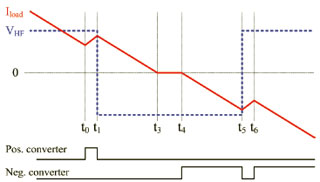Commutation Technique for High- Frequency-Link Switching Power Converter Based on State-Machine Control
Robert S. Balog Jr. with adviser Philip T. Krein

Figure 32: Conventional technique uses dead time which adds distortion at the zero-cross of the current.
This invention is a technique that resolves current commutation challenges in various types of ac-ac switching power converters. It also applies to inverters and rectifiers with high-frequency links. Direct ac-ac converters such as matrix converters and cycloconverters benefit from the approach. This technology commutates load current without inserting dead time, as shown in Figure 32, or using large inductors to limit shoot-through current. Both of these prior techniques intrinsically compromise a converter’s performance and efficiency.
The new technology provides a continuous path for load current and control of ac-ac converter switching so voltage sources do not short circuit and current sources are not open-circuited during commutation. If input voltage sources short circuit they result in dangerously high shoot-through currents, while a disruption in the load current results in dangerously high voltages. Either scenario can damage or destroy equipment. In the past, additional components or timing constraints were required to mitigate current commutation problems. This new technology prevents both shoot-through and loadcurrent disruption, and allows load-current zero-crossings to occur naturally without the distortion associated with prior techniques. The preferred embodiment of the new invention is a state-machine-based controller that tracks the switch-sequencing needed to avoid trouble.
A patent application for this technology was filed on August 11, 2005. Initial review accepted the primary claims for the commutation technique and asked for clarification on the system integration.
